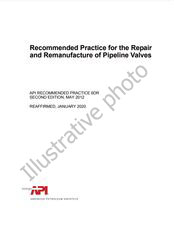We need your consent to use the individual data so that you can see information about your interests, among other things. Click "OK" to give your consent.

API PUBL 4717-ed.2002
Predictors of Water-Soluble Organics (WS0s) in Produced Water - A Literature Review
Translate name
STANDARD published on 1.3.2002
The information about the standard:
Designation standards: API PUBL 4717-ed.2002
Publication date standards: 1.3.2002
SKU: NS-1139873
The number of pages: 36
Approximate weight : 108 g (0.24 lbs)
Country: American technical standard
Category: Technical standards API
Annotation of standard text API PUBL 4717-ed.2002 :
API PUBL 4717, 2002 Edition, March 2002 - Predictors of Water-Soluble Organics (WS0s) in Produced Water - A Literature Review
Discharge of treated produced water to offshore waters of the United States is regulated by NPDES permits. Current general permits for the discharge of produced water to Federal offshore waters of the Gulf of Mexico have total oil and grease limits of 42 mg/L (ppm) daily maximum and 29 mg/L monthly average. EPA requires oil and grease concentrations in produced water to be monitored by EPA Method 413.1 or 1664. Both methods are gravimetric. The methods tend to overestimate the concentration of petroleum hydrocarbons in produced water, due to interference from dissolved non-hydrocarbon chemicals. The objective of this report is to evaluate the chemical composition of produced water from oil and gas wells, and identify the water-soluble organic chemicals (WSOs) in produced water that interfere with gravimetric determination of oil and grease. An initial assessment is made of the physical and chemical properties of the produced water and the associated fossil fuel reservoir, in an effort to predict which produced waters will contain high concentrations of WSOs.
Produced water may contain up to 1,000 mg/L total organic carbon (TOC), most of it in solution. Most of the dissolved organic carbon in produced water is accounted for by C2 through C5 organic acid anions, such as acetate, propionate, and butyrate. Acetic acid usually is the most abundant organic acid in produced water. These organic acids are identical to volatile organic acids produced by marine organisms and are not toxic or persistent in the marine environment.
A small fraction (usually less than 20%) of the dissolved organic matter in produced water is comprised of low molecular weight alkanes and aromatic hydrocarbons. The most abundant dissolved hydrocarbons in most produced waters are the aromatic hydrocarbons benzene, toluene, ethylbenzene, and xylenes (BTEX). BTEX concentrations usually are in the range of 0.07 to 500 mg/L. Benzene usually is the most abundant. Low concentrations of low molecular weight alkanes (C5 to C20) and traces of a few polycyclic aromatic hydrocarbons (PAHs) also may be present in produced water. The concentration of total PAHs usually is less than about 2 mg/L. Naphthalene and alkyl naphthalenes usually are the most abundant.
Phenols usually are present in produced water at concentrations lower than 20 mg/L. Phenol, C1- , and C2- phenols usually are the most abundant. Other dissolved hydrocarbon-like chemicals containing oxygen, sulfur, or nitrogen usually are present at trace concentrations.
Produced water contains in solution most of the non-metal inorganic and metal ions found in seawater. Many produced waters, including most of those from the U.S. Gulf of Mexico, have a salinity (total dissolved solids concentration) greater than that of sea water (» 35 g/kg). However, ionic ratios in produced water may be different from those in sea water. A few metals may be present in produced water from different sources at concentrations substantially higher (1,000-fold or more) than their concentrations in clean natural sea water. The metals most frequently present in produced water at elevated concentrations include barium, cadmium, chromium, copper, iron, lead, nickel, and zinc. Usually, only a few of these metals are present at elevated concentrations in a particular produced water sample. Produced water, particularly that from the Gulf of Mexico, contains radium isotopes (226Ra plus 228Ra) at concentrations up to about 2,800 pCi/L.
Organic acids are the quantitatively most important WSOs in produced water that interfere with the gravimetric methods for determination of total oil and grease. Although they are not extracted efficiently with the organic solvent used in the gravimetric methods (Freon ® or hexane), their concentrations in most produced waters are high enough that they contribute substantially to the mass of organic matter extracted from produced water. Treatment of the extract with silica gel (an option in Method 1664) decreases the amount of interfering non-hydrocarbon WSOs in the extract.
Organic acids in petroleum or produced water are thought to form by thermal degradation of oxygenated organic matter in source rocks or by hydrous pyrolysis of hydrocarbons. Organic acid anions are more soluble in water than in oil and, so, partition into produced water from the oil in the reservoir. The optimum temperature for these processes appears to be in the range of 80°C to 120°C. At lower reservoir temperatures, microbial degradation of organic acids decreases their concentrations in the produced water. At higher reservoir temperatures, organic acids are unstable and undergo thermal decarboxylation, forming CO2 and low molecular weight hydrocarbons (natural gas).
Because of these thermal processes, concentrations of total volatile organic acids in produced water tend to increase with increasing temperature below about 80°C, reach highest levels in reservoirs with temperatures between about 80°C and 120°C, and decline in reservoirs with higher temperatures. However, many secondary factors influence the concentration of organic acids in any given produced water. Thus, the relationship between temperature and organic acid concentration in produced water is only approximate. It is not possible to use reservoir temperature alone to predict the concentration of organic acids in produced water. The main secondary factors affecting organic acid concentrations in produ
We recommend:
Technical standards updating
Do you want to make sure you use only the valid technical standards?
We can offer you a solution which will provide you a monthly overview concerning the updating of standards which you use.
Would you like to know more? Look at this page.



 Cookies
Cookies
